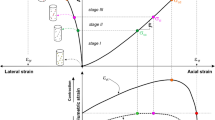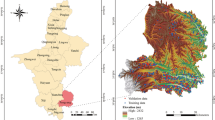Abstract
Rock mass classification systems are one of the most common ways of determining rock mass excavatability and related equipment assessment. However, the strength and weak points of such rating-based classifications have always been questionable. Such classification systems assign quantifiable values to predefined classified geotechnical parameters of rock mass. This causes particular ambiguities, leading to the misuse of such classifications in practical applications. Recently, intelligence system approaches such as artificial neural networks (ANNs) and neuro-fuzzy methods, along with multiple regression models, have been used successfully to overcome such uncertainties. The purpose of the present study is the construction of several models by using an adaptive neuro-fuzzy inference system (ANFIS) method with two data clustering approaches, including fuzzy c-means (FCM) clustering and subtractive clustering, an ANN and non-linear multiple regression to estimate the basic rock mass diggability index. A set of data from several case studies was used to obtain the real rock mass diggability index and compared to the predicted values by the constructed models. In conclusion, it was observed that ANFIS based on the FCM model shows higher accuracy and correlation with actual data compared to that of the ANN and multiple regression. As a result, one can use the assimilation of ANNs with fuzzy clustering-based models to construct such rigorous predictor tools.

















Similar content being viewed by others
References
Alvarez Grima M (2000) Neuro-fuzzy modeling in engineering geology. Balkema, Rotterdam
Alvarez Grima M, Babuška R (1999) Fuzzy model for the prediction of unconfined compressive strength of rock samples. Int J Rock Mech Min Sci 36:339–349
Bailey AD (1975) Rock types and seismic velocities versus rippability. In: Proceedings of the 26th Annual Highway Geology Symposium, Coeur d’Alene, Idaho, August 1975, pp 135–142
Bashari A, Beiki M, Talebinejad A (2011) Estimation of deformation modulus of rock masses by using fuzzy clustering-based modeling. Int J Rock Mech Min Sci 48:1224–1234
Bezdek JC (1981) Pattern recognition with fuzzy objective function algorithms. Plenum Press, New York
Bieniawski ZT (1989) Engineering rock mass classifications. Wiley, New York, 251 pp
Caterpillar Inc. (1980) Caterpillar performance handbook, 11th edn. Caterpillar, Peoria
Caterpillar Inc. (1988) Caterpillar performance handbook, 19th edn. Caterpillar, Peoria
Chiu SL (1994) Fuzzy model identification based on cluster estimation. J Intell Fuzzy Syst 2(3):267–278
Chun BS, Ryu WR, Sagong M, Do JN (2009) Indirect estimation of the rock deformation modulus based on polynomial and multiple regression analyses of the RMR system. Int J Rock Mech Min Sci 46(3):649–658
Demuth H, Beale M, Hagan M (2005) MATLAB version 7.8.0.347. Neural network toolbox for use with MATLAB. The MathWorks Inc., p 348
Dumitrescu D, Lazzerini B, Jain LC (2000) Fuzzy sets and their application to clustering and training. CRC Press, Boca Raton
Dunn JC (1973) A fuzzy relative of the ISODATA process and its use in detecting compact well-separated clusters. J Cybern 3:32–57
Gokceoglu C, Zorlu K (2004) A fuzzy model to predict the uniaxial compressive strength and the modulus of elasticity of a problematic rock. Eng Appl Artif Intell 17:61–72
Gokceoglu C, Yesilnacar E, Sonmez H, Kayabasi A (2004) A neuro-fuzzy model for modulus of deformation of jointed rock masses. Comput Geotech 31:375–383
Goktan RM, Eskikaya S (1991) Prediction of ripping machine performance in terms of rock mass properties. Civil Eng South Afr 31(1):13–24
Gong QM, Zhao J (2009) Development of a rock mass characteristics model for TBM penetration rate prediction. Int J Rock Mech Min Sci 46(1):8–18
Gunes Yilmaz N, Yurdakul M, Goktan RM (2007) Prediction of radial bit cutting force in high-strength rocks using multiple linear regression analysis. Int J Rock Mech Min Sci 44(6):962–970
Haykin S (1999) Neural networks: a comprehensive foundation, 2nd edn. Prentice Hall, Upper Saddle River, p 841
Hecht-Nielsen R (1987) Kolmogorov’s mapping neural network existence theorem. In: Proceedings of IEEE First International Conference on Neural Networks, San Diego, California, June 1987, pp 11–14
Howarth DF (1987) Mechanical rock excavation—assessment of cuttability and boreability. Proc RETC 1:145–164
Iphar M, Goktan RM (2006) An application of fuzzy sets to the Diggability Index Rating Method for surface mine equipment selection. Int J Rock Mech Min Sci 43:253–266
Iphar M (2012) ANN and ANFIS performance prediction models for hydraulic impact hammers. Tunn Undergr Space Technol 27:23–29
ISRM (1981) Rock characterization testing and monitoring. In: Brown TT (ed) ISRM suggested methods. Pergamon Press, Oxford p 211
Jalalifar H, Mojedifar S, Sahebi AA, Nezamabadi-pour H (2011) Application of the adaptive neuro-fuzzy inference system for prediction of a rock engineering classification system. Comput Geotech 38:783–790
Jang JSR (1999) ANFIS: adaptive-network-based fuzzy inference system. IEEE Trans Syst Man Cybern 23(3):665–685
Juang CH, Jhi YY, Lee DH (1998) Stability analysis of existing slopes considering uncertainty. Eng Geol 49:111–122
Kasabov NK (1998) Foundations of neural networks, fuzzy systems, and knowledge engineering. MIT Press, Cambridge
Kirsten HAD (1982) A classification system for excavation in natural materials. Civil Eng South Afr 24:293–308
Li W, Mei S, Zai S, Zhao S, Liang X (2006) Fuzzy models for analysis of rock mass displacements due to underground mining in mountainous areas. Int J Rock Mech Min Sci 43:503–511
Rumelhart DE, McClelland JL (1986) Parallel distributed processing: explorations in the microstructure of cognition, vols 1–2. MIT Press, Cambridge
Scoble MJ, Muftuoglu YV (1984) Derivation of a diggability index for surface mine equipment selection. Min Sci Technol 1:305–322
Sonmez H, Gokceoglu C, Ulusay R (2003) An application of fuzzy sets to the geological strength index (GSI) system used in rock engineering. Eng Appl Artif Intell 16:251–269
Sonmez H, Tuncay E, Gokceoglu C (2004) Models to predict the uniaxial compressive strength and the modulus of elasticity for Ankara agglomerate. Int J Rock Mech Min Sci 41:717–729
SPSS Inc. (2007) SPSS Regression Models (Version 16). http://www.winwrap.com
State Department of Highways, Colorado (1969) Rock rippability study (final report). State Department of Highways, Colorado, Rep Pb 189.842
Takagi T, Sugeno M (1985) Fuzzy identification of systems and its applications to modeling and control. IEEE Trans Syst Man Cybern 15:116–132
The MathWorks Inc. (2009) MATLAB. Fuzzy logic toolbox, user’s guide
Tutmez B, Tercan AE (2007) Spatial estimation of some mechanical properties of rocks by fuzzy modelling. Comput Geotech 34:10–18
Ulusay R, Gokceoglu C, Sulukcu S (2001) Draft ISRM suggested method for determining block punch strength index (BPI). Int J Rock Mech Min Sci 38:1113–1119
Yager R, Filev D (1994) Generation of fuzzy rules by mountain clustering. J Intell Fuzzy Syst 2(3):209–219
Yagiz S, Gokceoglu C (2010) Application of fuzzy inference system and nonlinear regression models for predicting rock brittleness. Exp Syst Appl 37:2265–2272
Zhou Q, Purvis M, Kasabov N (1997) A membership function selection method for fuzzy neural networks. In: Proc ICONIP, Dunedin, Springer Verlag Singapore, pp 785–788
Acknowledgments
The authors wish to thank the staff of the Anguran and Aghdarreh mines for facilitating the data gathering during this study. The authors who allowed us to use their data in this manuscript are gratefully thanked.
Author information
Authors and Affiliations
Corresponding author
Rights and permissions
About this article
Cite this article
Saeidi, O., Torabi, S.R. & Ataei, M. Prediction of the Rock Mass Diggability Index by Using Fuzzy Clustering-Based, ANN and Multiple Regression Methods. Rock Mech Rock Eng 47, 717–732 (2014). https://doi.org/10.1007/s00603-013-0426-3
Received:
Accepted:
Published:
Issue Date:
DOI: https://doi.org/10.1007/s00603-013-0426-3




